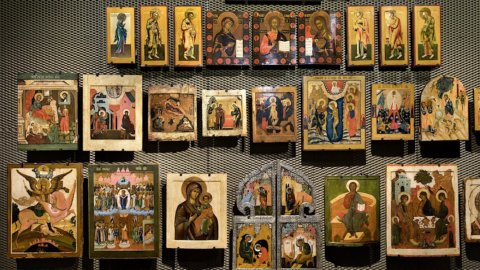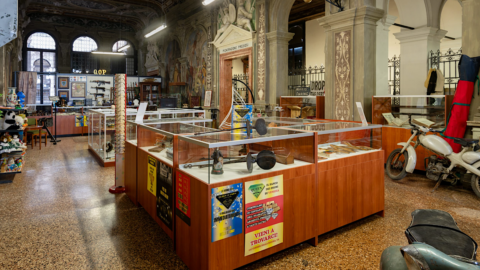Until 3 July 2022, the museum itinerary - in the spaces on the ground floor - is enriched by the dialogue with the works of the contemporary artist Valery Koshlyakov. The The project is curated by Silvia Burini and Giuseppe Barbieri, directors of the Center for Studies on the Arts of Russia (CSAR) of the Ca' Foscari University of Venice.
The selection of icons offers the possibility of contemplating a large sequence of masterpieces of sacred art in Russia, different in terms of eras and places of their production. Peculiar aspects of the iconic language – timbre color, compositional geometry, proportions of importance, inverted perspective – urge the observer to abandon schemes linked to representation based on criteria of verisimilitude, to discover the symbolic richness of a language only in naive appearance. Articulated in a thematic and diachronic key, the exhibition itinerary nonetheless allows us to grasp the gradual development over time, from the thirteenth to the nineteenth century, of this art practiced above all by iconographic monks, within the laboratories present in the cenobi.
Their artistic expression is destined to remain completely anonymous, without signature, as it is humbly and silently offered as an oblation to God and as a gift of charity (brotherly love) for the world. Spiritually guided by divine inspiration, the isographer "writes" his own visual message of faith by honoring the memory of tradition and ideally projecting this work towards the future, under the banner of the eschatological event. This perspective of hope extending beyond the limits of earthly life is symbolized by two ancient and precious examples, both dating back to the thirteenth century: the Ascension of the Prophet Elijah and the Descent of Christ into Hell. In a century marked by bloody dramas, these icons embody trust in a new time, finally capable of social justice and mercy.
The layout is designed with new museological criteria, to welcome and "tell" the icons through innovative ways of display and use: the choice was to move from an exhibition to an experience. The visitor is accompanied into the world of the representation of the sacred in the Russian tradition, which is embodied in the Orthodox rite, relived daily: the rite that Florensky indicated as a living "synthesis" of the arts by contrasting it with the neutral space of the "museum".
The first room of the exhibition itinerary, immersive and multisensory, is a narrative environment that initiates a dialogue between the millennial Russian civilization of the representation of the sacred and an updated "Western gaze", respectful and rigorous towards that tradition and at the same time committed to providing the visitor with adequate and stimulating reading keys essential to understand it. The room welcomes visitors at the beginning of their visual journey into Russian Orthodox spirituality and allows them to perceive the space in which icons are truly enjoyed: if for the West the icon is simply an artifact made in a particular historical period , in Russia it is instead an organism that is always alive. The icon is a word for images, an act of prayer and a liturgical instrument: it is not an object to be observed (and admired), but a living sign in a dimension of devotion and contemplation. Produced by Studio Arts Media of Moscow, directed by Nikita Tikhonov, the video immerses us in the intensity of the rites of the Church of the Annunciation of the Most Holy Mother of God, in the village of Pavlovskaja Sloboda, in the Moscow Region.
In the second room, together with some of the most representative icons of the collection, about thirty panels have been juxtaposed to form a sort of evocative iconostasis (the wall that in Orthodox churches separates the space for the faithful from the presbytery which can only be accessed by priests), so as to allow visitors to effectively understand the primary function of icons in the Russian tradition.
In the third room periodically, a dialogue is proposed between the world of the icon and modern and contemporary artistic expressions, which refer to that ancient matrix. On this occasion the comparison is with one of the greatest living Russian artists, Valery Koshlyakov.
Born in 1962 in Sal'sk, southern Russia, Koshlyakov he has lived in Paris for many years and to create his works he often uses materials of explicit poverty: cardboard, packing tape, superimposed layers of oil paint and spray paint. After a long and capillary reconnaissance of popular architectures and everyday objects which, in his opinion, referred to the compositional structure of the icon, Koshlyakov has created in the last few decades a large sequence of ikonosy, suggestive signs which bring together the structures of the backgrounds of the icon to the actuality of the present. The Celestial Architectures exhibition is made up of a nucleus of site-specific ikonosys, specially created by the artist in close dialogue with four icons selected from the Intesa Sanpaolo collection, in which the presence of details can be seen which then "migrated", transforming themselves into his architectural fantasies.
In the fourth and last room, together with educational content on the icon-making technique, some metal coatings are on display – rize and basme – which have protected and embellished the painted panels over the centuries.
The exhibition itinerary concludes with a touchscreen multimedia installation, curated by camerAnebbia, Milan, which provides essential information on the icon and its stages of creation, with a specific focus on the menologists, icons that represent the saints and religious festivals of the liturgical calendar.
Also new is the vault in which the icons of the collection not presented in the exhibition halls are kept, available (upon request) to scholars and connoisseurs.





